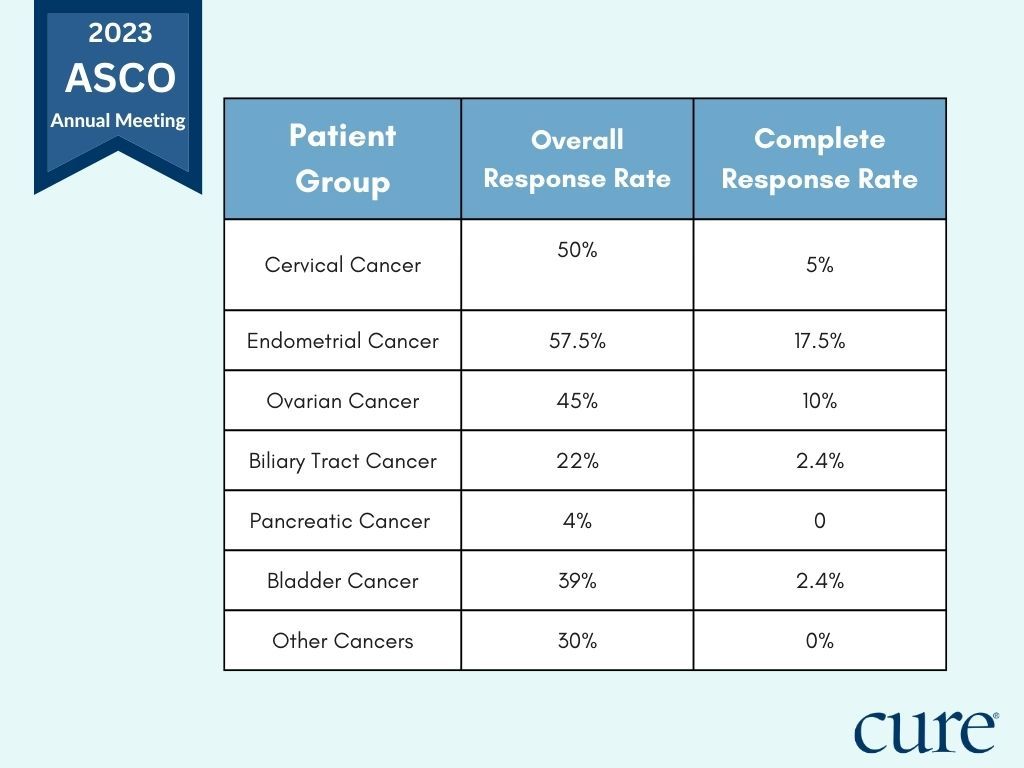Article
Enhertu Is Promising for Difficult-to-Treat Solid Cancers
Author(s):
Enhertu (fam-trastuzumab deruxtecan-nxki) demonstrated activity across multiple types of solid cancers — including some that are notoriously difficult to treat— according to findings from the phase 2 DESTINY-PanTumor02 trial (NCT04482309) presented during the 2023 ASCO Annual Meeting.
Enhertu led to responses across multiple different tumor types.

Results from the study showed that at the Nov. 16, 2022, data cutoff, patients with cervical (40 patients), endometrial (40), ovarian (40), biliary tract (41) pancreatic (25), bladder (41), and other cancers (40) experienced investigator-assessed overall response rates (percentage of patients whose disease shrinks or disappears as a result of treatment) of 50.0%, 57.5%, 45.0%, 22.0%, 4.0%, 39.0%, and 30.0%, respectively.
The complete response rates — which is the percentage of patients whose disease completely disappears — were 5.0%, 17.5%, 10.0%, 2.4%, 0%, 2.4%, and 0% respectively. The overall response rate in the total population (267 patients) was 37.1%, including a 5.6% complete response rate.
Among all responders, the duration of objective response at 12 months was 49.6%. Specifically in the cervical, endometrial, ovarian, biliary tract, pancreatic, bladder and other cohorts, these rates were 47.6%, 72.3%, 45.8%, 41.7%, 0%, 23.2%, and 53.6%, respectively.
“(Enhertu) is a potent antibody-drug conjugate that has become a standard of care for HER2-low as well as HER2-positive breast cancer, HER2-positive gastric cancer, and HER2-mutant lung cancer,” Dr. Funda Meric-Bernstam, said in a presentation of the data. Meric-Bernstam is chair of the Department of Investigational Cancer Therapeutics—the Phase I Program, medical director of the Institute for Personalized Cancer Therapy (IPCT), and the Nellie B. Connally Chair in Breast Cancer at MD Anderson Cancer Center in Houston, Texas. “However, HER2 is expressed across a variety of other tumor types, and for these patients there are no approved HER2-targeted treatments, and often the disease is refractive to standard-of-care therapies. In early-phase studies (Enhertu) demonstrated activity in several tumor types, including salivary gland, biliary (tract) and endometrial cancers.”
DESTINY-PanTumor02 was an open-label, multicenter study of patients with advanced solid tumors who were not eligible for curative therapy. Patients needed to be in their second line or later of therapy, have a HER2 expression and have little to no impairments to perform their daily tasks. Prior HER2-directed therapy was permitted. Enhertu was administered at a dose of 5.4 mg/kg every three weeks in all groups.
The primary end point was confirmed overall response rate by investigator. Secondary end points included disease control rate, duration of response, progression-free survival, overall survival and safety.
The safety profile of Enhertu was found to be consistent with the known profile of the agent. In the overall population, common any-grade treatment-emergent side effects included nausea (54.3%), fatigue (37.8%), neutropenia (32.6%), anemia (25.8%), diarrhea (25.5%), vomiting (24.3%), decreased appetite (16.5%), thrombocytopenia (16.5%), alopecia (16.1%) and leukopenia (10.1%). These side effects occurred at a grade 3 or higher severity in 3.4%, 6.0%, 19.1%, 8.6%, 3.7%, 1.5%, 1.5%, 5.2%, 0.0%, and 2.6% of patients, respectively.
Regarding interstitial lung disease and pneumonitis related to treatment with Enhertu, any-grade events were reported in 7.5% of patients. Most instances were grade 2 (4.5%), although grade 1 (2.2%), grade 3 (0.4%), and grade 5 (0.4%) events were also reported.
Any grade left ventricular dysfunction events were rare and consisted of decreased ejection fracation (2.6%) and cardiac failure (0.4%). Grade 1 (0.4%), grade 2 (1.5%), and grade 3 (0.4%) left ventricular dysfunction events occurred. The only instance of cardiac failure was grade 3 in severity.
Drug-related side effects that were associated with dose discontinuations occurred at a rate of 8.2% and 12.0% of patients experienced serious drug-related side effects. Drug-related side effects associated with dose interruptions, dose reductions and deaths were reported in 18.4%, 18.7%, and 0.7% of patients, respectively.
Patients in the cervical, endometrial, ovarian, biliary tract, pancreatic, bladder and other cohorts, were still on treatment at the data cutoff at rates of 25.0%, 65.0%, 15.0%, 7.3%, 4.0%, 12.2% and 12.5%, respectively.
Overall, 83.5% of patients discontinued treatment. Reasons for discontinuation included disease progression (58.4%), side effects (11.2%) and other (13.9%).
Additional findings from the study revealed that the median duration of response were 9.8 months, not reached, 11.3 months, 8.6 months, not reached, 8.7 months and not reached in the cervical, endometrial, ovarian, biliary tract, pancreatic, bladder, and other cohorts, respectively. The 12-week disease-control rates were 67.5%, 80.0%, 70.0%, 65.9%, 36.0%, 70.7% and 75.0%, respectively.
Notably, patients with a HER2 status of IHC 3+ generally experienced heightened response rates. The overall response rates among patients with an IHC of 3+ were 75.0%, 84.6%, 63.6%, 56.3%, 0.0%, 56.3% and 44.4%, in the cervical (eight patients), endometrial (13 patients), ovarian (11 patients), biliary tract (16 patients), pancreatic (two patients), bladder (16 patients) and other (nine patients) cohorts, respectively. Comparatively, the overall response rates for patients with a HER2 of IHC 2+ were 40.0%, 47.1%, 36.8%, 0.0%, 5.3%, 35.0% and 18.8 % in the cervical (20 patients), endometrial (17), ovarian (19), biliary tract (14), pancreatic (19), bladder (20), and other (16) groups, respectively.
The median duration of response for all patients with an IHC of 3+ was 22.1 months and was 9.8 months among those with an IHC of 2+. Overall, the median duration of response was 11.8 months.
“These were durable responses,” Meric-Bernstam said. “The trial is still ongoing, and we will be reporting overall survival and progression-free survival (data) at a later date. However, data to date suggest that (Enhertu) has broad activity and could represent a new therapy option in patients that are HER2-positive.”
For more news on cancer updates, research and education, don’t forget to subscribe to CURE®’s newsletters here.





